


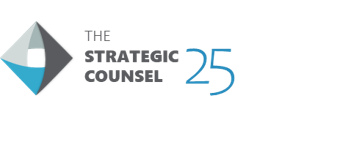
Target audience
| LOCATION | GROUP | LANGUAGE | DATE | TIME (EST) | GROUP COMPOSITION | NUMBER OF PARTICIPANTS |
|---|---|---|---|---|---|---|
| Nova Scotia | 1 | English | Oct. 1 | 5:00-7:00 pm | Gen Pop | 8 |
| Greater Montreal Area | 2 | French | Oct. 5 | 6:00-8:00 pm | Racialized Canadians | 8 |
| Greater Toronto/ Hamilton Area | 3 | English | Oct. 7 | 6:00-8:00 pm | Racialized Canadians | 8 |
| Atlantic Canada | 4 | English | Oct. 13 | 5:00-7:00 pm | Indigenous | 8 |
| Ontario – Mid-size & Major Centres | 5 | English | Oct. 14 | 6:00-8:00 pm | On EI/Recovery benefits | 7 |
| Quebec City | 6 | French | Oct. 15 | 6:00-8:00 pm | Gen Pop | 4 |
| Alberta – Northern Communities | 7 | English | Oct. 19 | 8:00-10:00 pm | Gen Pop | 6 |
| Manitoba | 8 | English | Oct. 20 | 7:00-9:00 pm | Gen Pop | 7 |
| Yellowknife | 9 | English | Oct. 21 | 8:00-10:00 pm | Gen Pop | 6 |
| Ontario – Ottawa-Carleton, Toronto, Peel Region | 10 | English | Oct. 26 | 6:00-8:00 pm | Gen Pop | 6 |
| Quebec - Mid-size Centres | 11 | French | Oct. 27 | 6:00-8:00 pm | On EI/Recovery benefits | 4 |
| Ontario – Mid-size towns in Eastern and Southern Ontario | 12 | English | Oct. 29 | 6:00-8:00 pm | Gen Pop | 8 |
| Total number of participants | 80 | |||||
The animated storyboard above features a series of frames, accompanied by music and a narrator voiceover. The background imagery is in greyscale, with the animated characters in colour. The narrator reads the following as different sequences of animations are shown on screen: “As we continue to fight the spread of COVID-19, there are new support programs in place for those who need them. Including an expanded, more accessible EI and a series of Canada recovery benefits. Continuing to support Canadians now, will help keep Canada safe and strong. Visit Canada.ca/coronavirus to learn about the new financial support programs. A message from the Government of Canada.”
Images shown on screen are of a city block, with the camera slowly moving up and looking through a window into a Canadian family’s home. On the street level we see an artist painting, a man playing a guitar, and a younger woman walking with an elderly woman. As the video pans, we see a man carrying a bag of groceries, a man walking his dog and a woman riding her bicycle. All of these characters are seen wearing masks. Once the camera focuses on the window of a Canadian family, we see a man setting groceries on the counter and joining a woman who is sitting at a table with her children. One child is on a laptop and another is sitting in a highchair eating. This scene then becomes outlines by a maple leaf, with the rest of the screen becoming a dark blue background and Canada/ca/coronavirus is shown top of the screen in white font. The Canada Wordmark is then shown.
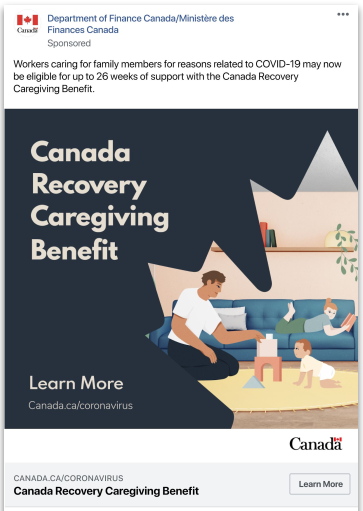
The figure above shows a Facebook ad sponsored by the Department of Finance Canada. The ad’s main headline (at the top of the ad) reads: “Workers caring for family members for reasons related to COVID-19 may now be eligible for up to 26 weeks of support with the Canada Recovery Caregiving Benefit.” The main image in the ad features a navy blue background with a graphic image (on the right) of a father playing with two young children in a living room, which is framed by a maple leaf. In the image, one child is laying on a couch reading a book and the other is playing with blocks with the father on the floor. To the top left of the leaf and image on the dark blue background, white text reads “Canada Recovery Caregiving Benefit” and “Learn more” with the URL “Canada.ca/coronavirus” is included at the bottom left of the image. The Canada Wordmark appears at the bottom right of the ad.

The figure above features a graphic image of a young woman who is walking with an elderly woman through a park on a paved pathway with leaves on the ground. The elderly woman is walking with a cane and both women are wearing face masks. The background features graphics of trees, park benches, as well as a man painting a picture.
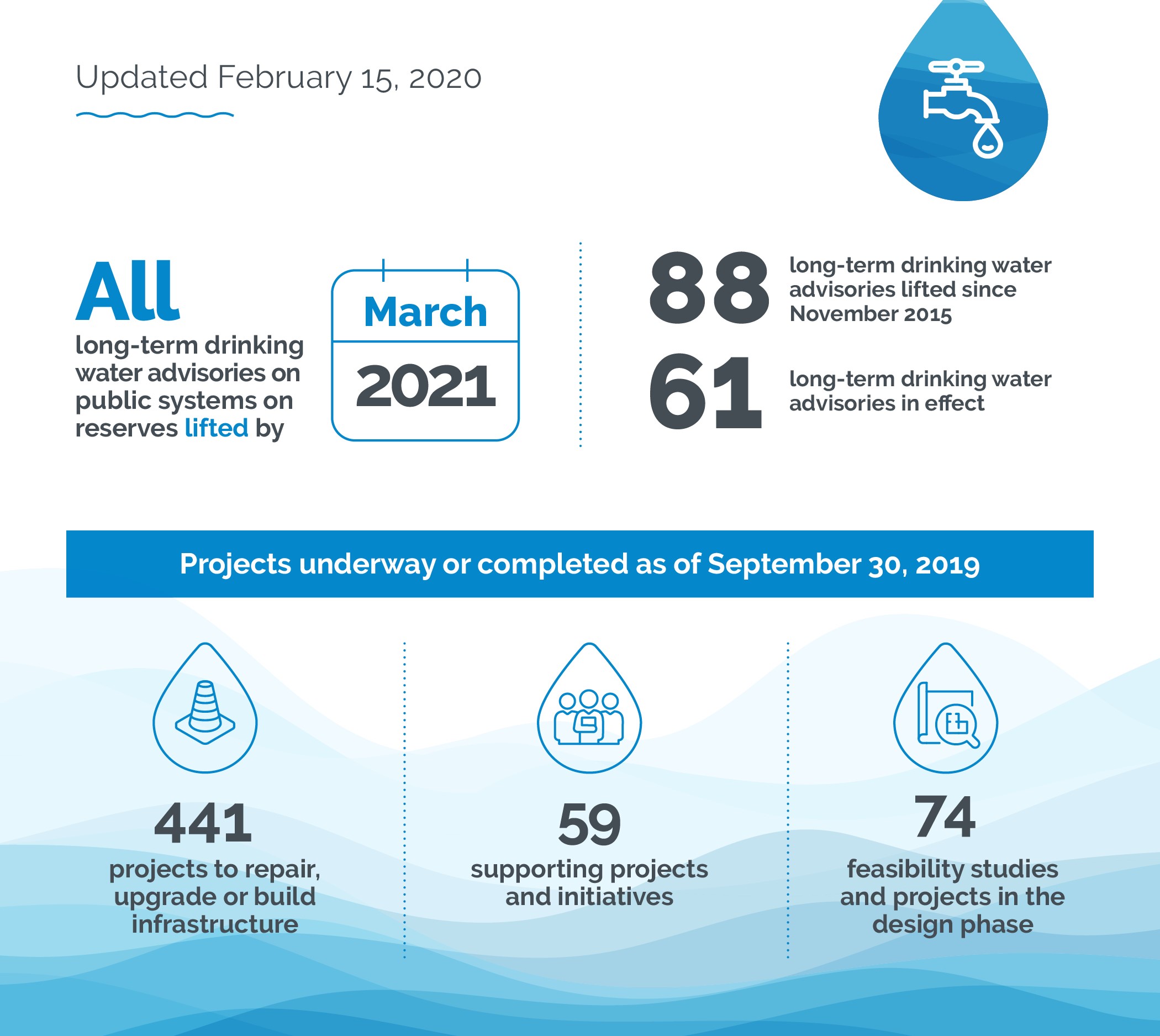
This infographic features a white background with a graphic of blue waves across the bottom third of the page. On the top left, the version date “Updated February 15, 2020” in written grey font underlined by a dark blue waved line. On the top right, there is a blue water droplet with a white icon of a tap inside that is leaking a drop of water. In the middle of the infographic to the left, text reads, “All long-term drinking water advisories on public systems on reserved lifted by” in grey font, but the words “all” and “lifted” are in blue. Next to this text, there is a calendar icon with “March 2021” written inside. In the middle of the infographic to the right, text reads “88 long-term drinking water advisories lifted since November 2015” and “61 long-term drinking water advisories in effect.” At the bottom of the infographic, spanning across the page, a blue banner reads, “Projects underway or completed as of September 30, 2019” in white text. The bottom third of the infographic is divided into three sections separated by dotted lines. Each section features an icon of a blue water droplet icon and a statistic. The left section shows pylon icon in the water droplet and, below it, in grey text reads “441 projects to repair, upgrade or build infrastructure.” The middle section features an icon of three people in the water droplet and, below it, in grey text reads “59 supporting projects and initiatives”. The right section features a map icon with a magnifying glass and, below it, in grey text reads “74 feasibility studies and projects in the design phase.”
| GROUP | DATE | TIME (EST) | TIME (LOCAL) | LOCATION | COMPOSITION | MODERATOR |
|---|---|---|---|---|---|---|
| 1 | Oct. 1 | 5:00-7:00 | 6:00-8:00 ADT | Nova Scotia | Gen Pop | DN |
| 3 | Oct. 7 | 6:00-8:00 | 6:00-8:00 EST | GTHA | Racialized Canadians | DN |
| 4 | Oct. 13 | 5:00-7:00 | 6:00-8:00 ADT | Atlantic Canada | Indigenous | DN |
| 5 | Oct. 14 | 6:00-8:00 | 6:00-8:00 EST | Ontario – Mid-size and Major Centres | On CERB Replacements | TBW |
| 7 | Oct. 19 | 8:00-10:00 | 6:00-8:00 MDT | Alberta – Northern Communities | Gen Pop | TBW |
| 8 | Oct. 20 | 7:00-9:00 | 6:00-8:00 CDT | Manitoba | Gen Pop | DN |
| 9 | Oct. 21 | 8:00-10:00 | 6:00-8:00 MDT | Yellowknife | Gen Pop | TBW |
| 10 | Oct. 26 | 6:00-8:00 | 6:00-8:00 EST | Ontario – Ottawa-Carleton, Toronto, Peel Region | Gen Pop | DN |
| 12 | Oct. 29 | 6:00-8:00 | 6:00-8:00 EST | Ontario – Mid-Size Towns in Eastern and Southern Ontario | Gen Pop | DN |
| LOCATION | CITIES | |
|---|---|---|
| Nova Scotia | Cities could include (but are not limited to): Amherst, Antigonish, Bridgewater, Cape Breton, Halifax, Kentville, New Glasgow, Truro, Wolfville, Yarmouth MAX OF 3 PARTICIPANTS FROM HALIFAX. ENSURE A GOOD MIX OF CITIES ACROSS THE REGION. INCLUDE THOSE RESIDING IN LARGER AND SMALLER COMMUNITIES. |
CONTINUE - GROUP 1 |
| GTHA | Cities could include (but are not limited to): City of Toronto, Hamilton, Durham Region, Halton Region, Peel Region, York Region, Dufferin County, Simcoe County ENSURE A GOOD MIX OF CITIES ACROSS THE REGION. |
CONTINUE - GROUP 3 |
| Atlantic Canada | Cities could include (but are not limited to):
NS: Halifax, Cape Breton
NB: Moncton, Saint John, Fredericton, Dieppe, Miramichi, Edmundston
PEI: Charlottetown, Summerside
N&L: St. John’s, Conception Bay, Mount Pearl, Corner Brook ENSURE A GOOD MIX OF CITIES ACROSS EACH OF THE FOUR PROVINCES. |
CONTINUE - GROUP 4 |
| Ontario – Mid-size and Major Centres | Mid-size centres: ~100,000 – 300,000 in population
Not immediately adjacent to a major center
Cities could include (but are not limited to): Barrie, Brantford, Cambridge, Chatham-Kent, Guelph, Kingston, Kitchener, London, Milton, St. Catharines-Niagara, Sudbury, Waterloo, Windsor ENSURE 4 PARTICIPANTS FROM THESE REGIONS. ENSURE A GOOD MIX OF CITIES ACROSS THE REGION. Larger centers: Cities could include (but are not limited to): Toronto, Ottawa-Gatineau, Mississauga, Brampton, Hamilton ENSURE 4 PARTICIPANTS FROM THESE REGIONS. NO MORE THAN 1 PER CITY. ENSURE A GOOD MIX OF CITIES ACROSS THE REGION. |
CONTINUE GROUP 5 |
| Alberta – Northern Communities | Cities could include (but are not limited to): Fort McMurray, Peace River, Grand Prairie, Slave Lake, Cold Lake, Whitecourt, Athabasca, Grimshaw, Fairview, Rainbow Lake, Wembley NO MORE THAN 2 PER CITY. ENSURE A GOOD MIX OF CITIES ACROSS THE REGION. INCLUDE THOSE RESIDING IN LARGER AND SMALLER COMMUNITIES. |
CONTINUE - GROUP 7 |
| Manitoba | Cities could include (but are not limited to): Winnipeg, Brandon, Steinbach, Thompson, Portage La Prairie, Winkler, Selkirk, Dauphin, Morden, Flin Flon, The Pas, Stonewall, Swan River, Virden MAX 2 PARTICIPANTS FROM EACH MAJOR CITY - WINNIPEG AND BRANDON. ENSURE A GOOD MIX OF CITIES ACROSS THE REGION. INCLUDE THOSE RESIDING IN LARGER AND SMALLER COMMUNITIES. |
CONTINUE - GROUP 8 |
| Yellowknife | Yellowknife PARTICIPANTS SHOULD RESIDE IN THE ABOVE-NOTED CENTERS PROPER. | CONTINUE - GROUP 9 |
| Ontario | Ottawa-Carleton, Toronto, Peel Region (Brampton, Mississauga) ENSURE A GOOD MIX OF CITIES. |
CONTINUE - GROUP 10 |
| Ontario – Mid-size Towns in Eastern and Southern Ontario | Mid-size centres: ~100,000 – 300,000 in population
Not immediately adjacent to a major center
EASTERN ONTARIO: Cities could include (but are not limited to): East and southeast of Ottawa and suburbs, Kingston, Cornwall. Includes counties of Prescott, Russell, Stormont, Dundas and Glengary, Lanark, Renfrew, Leeds and Grenville, Frontenac, Lennox and Addington, Hastings, Prince Edward ENSURE 4 PARTICIPANTS FROM THESE REGIONS. ENSURE A GOOD MIX OF CITIES ACROSS THE REGION. SOUTHERN ONTARIO: Cities could include (but are not limited to): St. Catharines-Niagara, Oshawa, Windsor, Barrie, Guelph, Brantford, Peterborough, Kitchener, Cambridge, Waterloo ENSURE 4 PARTICIPANTS FROM THESE REGIONS. ENSURE A GOOD MIX OF CITIES ACROSS THE REGION. |
CONTINUE - GROUP 12 |
| Other | - | THANK AND END |
| VOLUNTEERED Prefer not to answer | - | THANK AND END |
| Less than two years | THANK AND END |
|---|---|
| Two years or more | CONTINUE |
| Don’t know/Prefer not to answer | THANK AND END |
| Yes | CONTINUE |
|---|---|
| No | THANK AND END |
| Don’t know/Prefer not to answer |
| Under 18 years of age | IF POSSIBLE, ASK FOR SOMEONE OVER 18 AND REINTRODUCE. OTHERWISE THANK AND END. |
|---|---|
| 18-24 | CONTINUE ENSURE A GOOD MIX OF AGES WITHIN EACH GROUP. |
| 25-34 | |
| 35-44 | |
| 45-54 | |
| 55+ | |
| VOLUNTEERED Prefer not to answer | THANK AND END |
| GROUPE | DATE | HEURE (DE L’EST) | LIEU | COMPOSITION DU GROUPE | MODÉRATEUR |
|---|---|---|---|---|---|
| 2 | 5 octobre | 18 h-20 h | Grande région de Montréal – y compris Montréal même | Canadiens racialisés | M. Proulx |
| 6 | 15 octobre | 18 h-20 h | Québec – Outaouais, ville de Québec, région de Gaspé | Population générale | M. Proulx |
| 11 | 27 octobre | 18 h-20 h | Québec – Grandes villes | Bénéficiaires de prestations qui remplacent la PCU | M. Proulx |
| LIEU | VILLES | |
|---|---|---|
| Grande région de Montréal (GRM) – y compris Montréal même | Les villes de la GRM peuvent notamment comprendre : Montréal, Laval, Longueuil, Terrebonne, Brossard, Saint-Jérôme, Blainville, Mirabel, Dollard-des-Ormeaux PAS PLUS DE DEUX PARTICIPANTS DE LA VILLE DE MONTRÉAL. ASSURER UNE BONNE REPRÉSENTATION DES VILLES DANS CHAQUE LIEU. |
CONTINUER - GROUPE 2 |
| Québec – Outaouais, ville de Québec, région de Gaspé | Les villes de l’Outaouais peuvent notamment comprendre : Gatineau (Hull, Aylmer, Gatineau, Masson-Angers, Buckingham), la région de Pontiac, Chelsea, Papineauville, Gracefield, Montebello, Maniwaki Ville de Québec LES PARTICIPANTS DOIVENT RÉSIDER DANS CES VILLES. Région de Gaspé : En plus de la ville de Gaspé, le territoire de Gaspé comprend les municipalités de Cap-aux-Os, Cap-des-Rosiers, Douglastown, Haldimand, Jersey Cove, L’Anse-à-Fugère, L’Anse-à-Valleau, L’Anse-au-Griffon, Penouille, Petit-Cap, Petite-Rivière-au-Renard, Pointe-Jaune, Rivière-au-Renard, Rivière-Morris, Sandy Beach, Saint-Majorique, Saint-Maurice-de-l’Échouerie, Wakeham et York. ASSURER UNE BONNE REPRÉSENTATION DES VILLES DANS CHAQUE LIEU. |
CONTINUER - GROUPE 6 |
| Québec – Grandes villes | Villes de taille importante à l’extérieur de la GRM et de la ville de Québec Ces villes peuvent notamment comprendre : Sherbrooke, Trois-Rivières, Chicoutimi – Jonquière, Saint-Jean-sur-Richelieu, Saint-Jérôme ASSURER UNE BONNE REPRÉSENTATION DES VILLES DANS CHAQUE LIEU. |
CONTINUER- GROUPE 11 |
| Autre lieu | - | REMERCIER ET CONCLURE |
| RÉPONSE SPONTANÉE Préfère ne pas répondre | - | REMERCIER ET CONCLURE |
| Moins de deux ans | REMERCIER ET CONCLURE |
|---|---|
| Deux ans ou plus | CONTINUER |
| Ne sais pas/Préfère ne pas répondre | REMERCIER ET CONCLURE |
| Moins de 18 ans | SI POSSIBLE, DEMANDER À PARLER À UNE PERSONNE DE 18 ANS OU PLUS ET REFAIRE L’INTRODUCTION. SINON, REMERCIER ET CONCLURE. |
|---|---|
| 18 à 24 | CONTINUER ASSURER UNE BONNE REPRÉSENTATION DES ÂGES DANS CHAQUE GROUPE. |
| 25 à 34 | |
| 35 à 44 | |
| 45 à 54 | |
| 55 ans ou plus | |
| RÉPONSE SPONTANÉE Préfère ne pas répondre | REMERCIER ET CONCLURE |
The animated storyboard above features a series of frames, accompanied by music and a narrator voiceover. The background imagery is in greyscale, with the animated characters in colour. The narrator reads the following as different sequences of animations are shown on screen: “As we continue to fight the spread of COVID-19, there are new support programs in place for those who need them. Including an expanded, more accessible EI and a series of Canada recovery benefits. Continuing to support Canadians now, will help keep Canada safe and strong. Visit Canada.ca/coronavirus to learn about the new financial support programs. A message from the Government of Canada.”
Images shown on screen are of a city block, with the camera slowly moving up and looking through a window into a Canadian family’s home. On the street level we see an artist painting, a man playing a guitar, and a younger woman walking with an elderly woman. As the video pans, we see a man carrying a bag of groceries, a man walking his dog and a woman riding her bicycle. All of these characters are seen wearing masks. Once the camera focuses on the window of a Canadian family, we see a man setting groceries on the counter and joining a woman who is sitting at a table with her children. One child is on a laptop and another is sitting in a highchair eating. This scene then becomes outlines by a maple leaf, with the rest of the screen becoming a dark blue background and Canada/ca/coronavirus is shown top of the screen in white font. The Canada Wordmark is then shown.
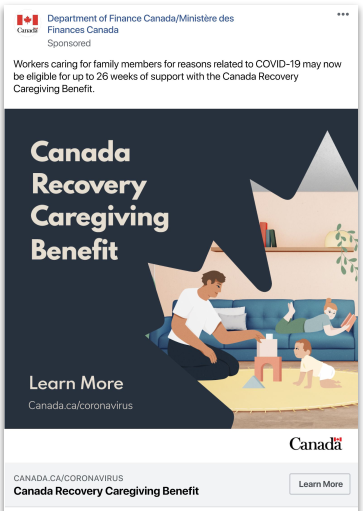
The figure above shows a Facebook ad sponsored by the Department of Finance Canada. The ad’s main headline (at the top of the ad) reads: “Workers caring for family members for reasons related to COVID-19 may now be eligible for up to 26 weeks of support with the Canada Recovery Caregiving Benefit.” The main image in the ad features a navy blue background with a graphic image (on the right) of a father playing with two young children in a living room, which is framed by a maple leaf. In the image, one child is laying on a couch reading a book and the other is playing with blocks with the father on the floor. To the top left of the leaf and image on the dark blue background, white text reads “Canada Recovery Caregiving Benefit” and “Learn more” with the URL “Canada.ca/coronavirus” is included at the bottom left of the image. The Canada Wordmark appears at the bottom right of the ad.
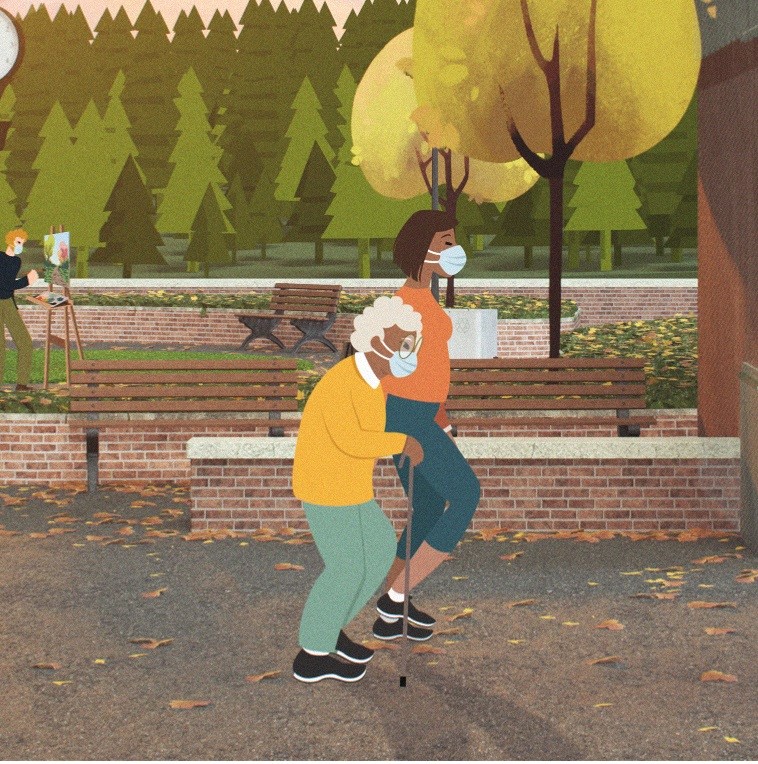
The figure above features a graphic image of a young woman who is walking with an elderly woman through a park on a paved pathway with leaves on the ground. The elderly woman is walking with a cane and both women are wearing face masks. The background features graphics of trees, park benches, as well as a man painting a picture.
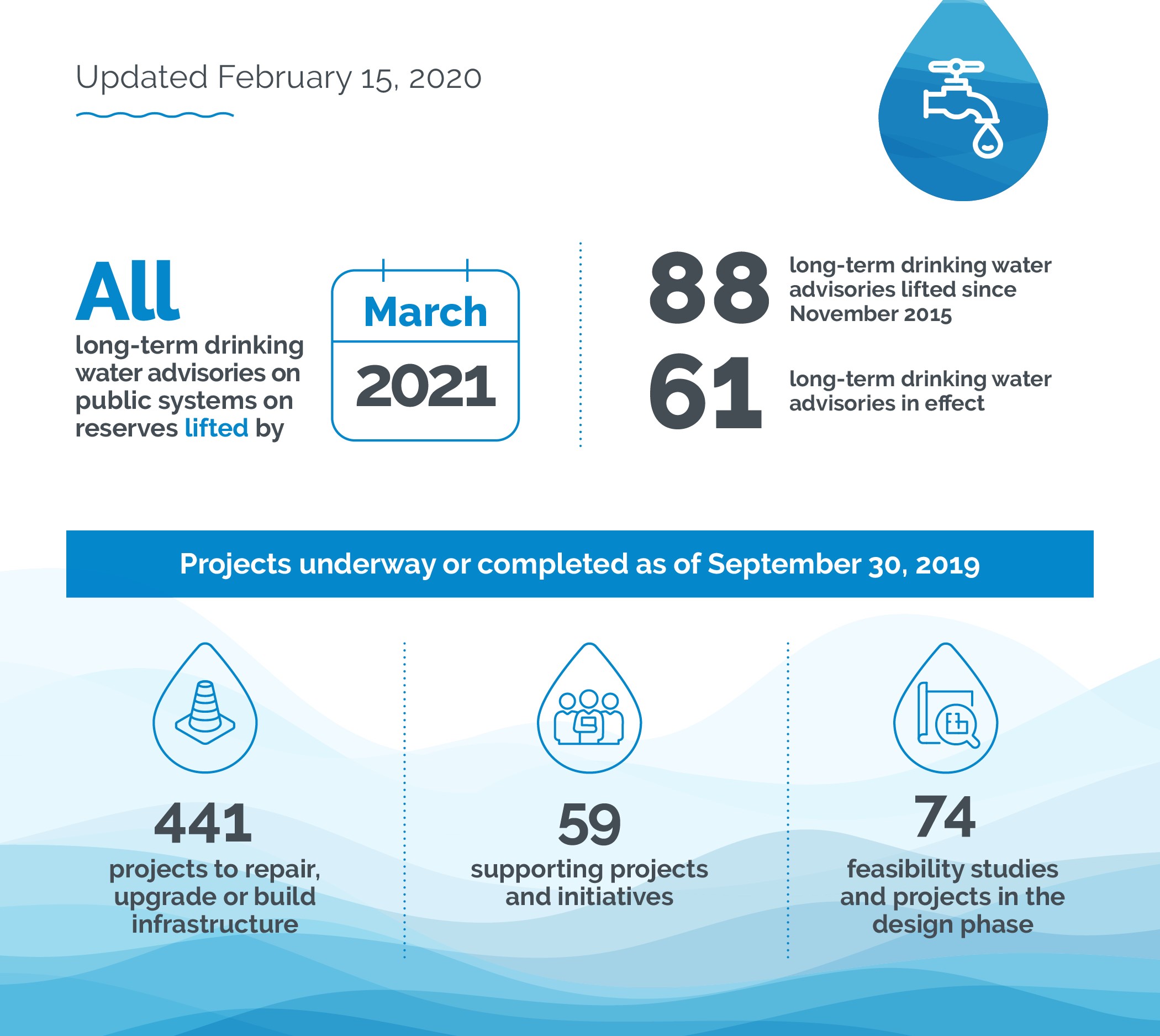
This infographic features a white background with a graphic of blue waves across the bottom third of the page. On the top left, the version date “Updated February 15, 2020” in written grey font underlined by a dark blue waved line. On the top right, there is a blue water droplet with a white icon of a tap inside that is leaking a drop of water. In the middle of the infographic to the left, text reads, “All long-term drinking water advisories on public systems on reserved lifted by” in grey font, but the words “all” and “lifted” are in blue. Next to this text, there is a calendar icon with “March 2021” written inside. In the middle of the infographic to the right, text reads “88 long-term drinking water advisories lifted since November 2015” and “61 long-term drinking water advisories in effect.” At the bottom of the infographic, spanning across the page, a blue banner reads, “Projects underway or completed as of September 30, 2019” in white text. The bottom third of the infographic is divided into three sections separated by dotted lines. Each section features an icon of a blue water droplet icon and a statistic. The left section shows pylon icon in the water droplet and, below it, in grey text reads “441 projects to repair, upgrade or build infrastructure.” The middle section features an icon of three people in the water droplet and, below it, in grey text reads “59 supporting projects and initiatives”. The right section features a map icon with a magnifying glass and, below it, in grey text reads “74 feasibility studies and projects in the design phase.”